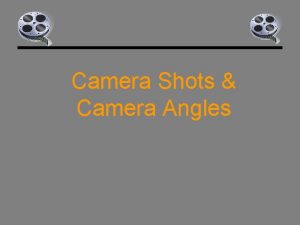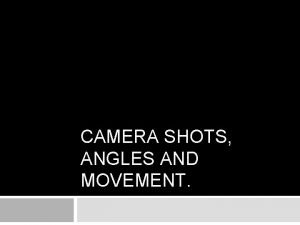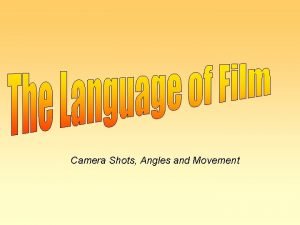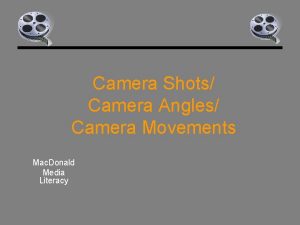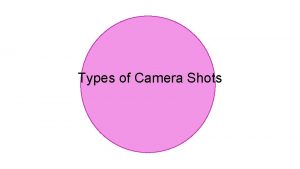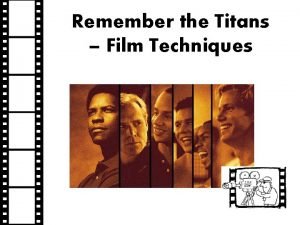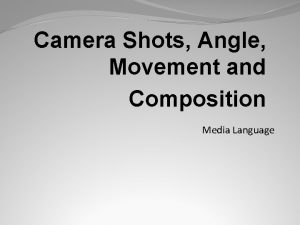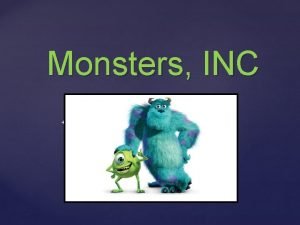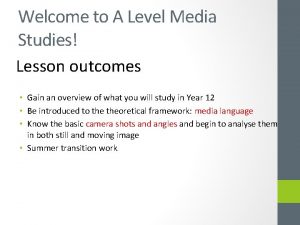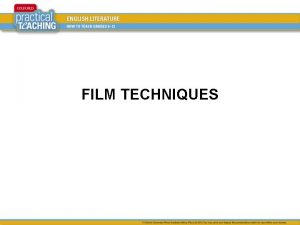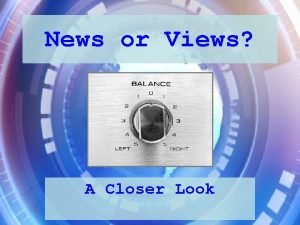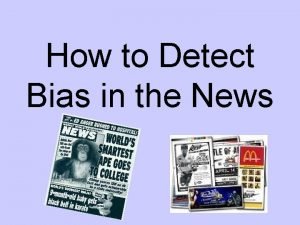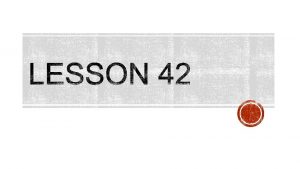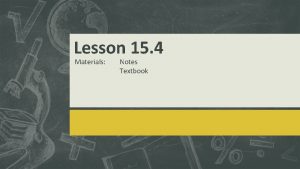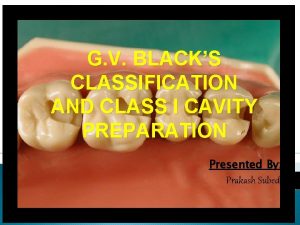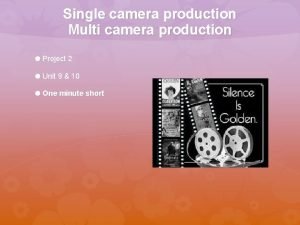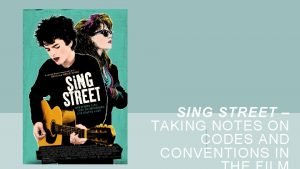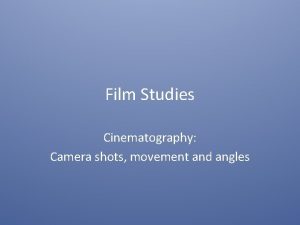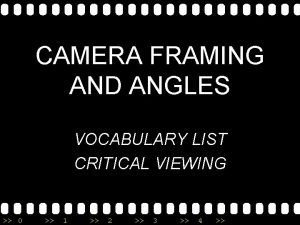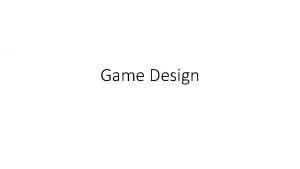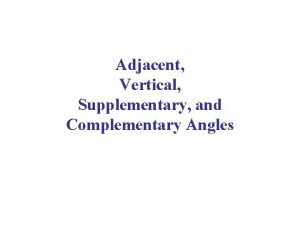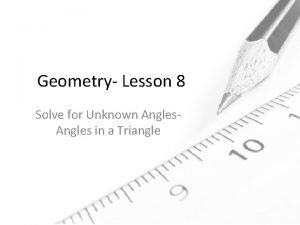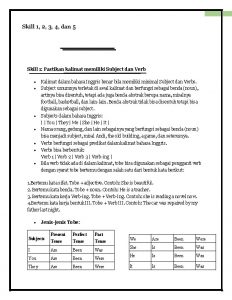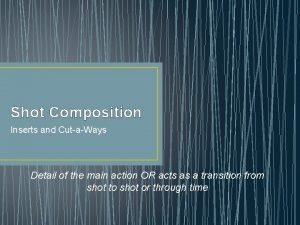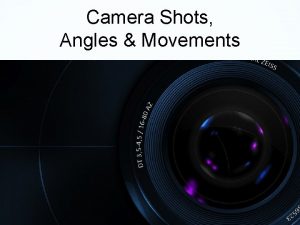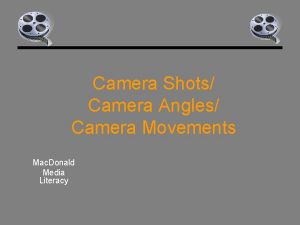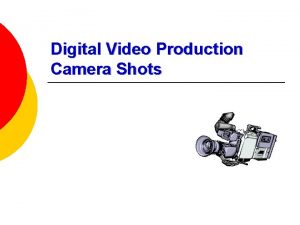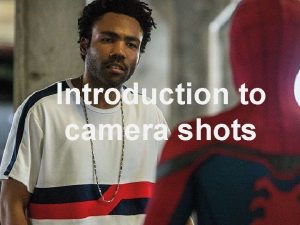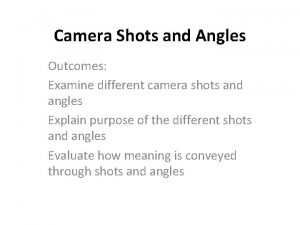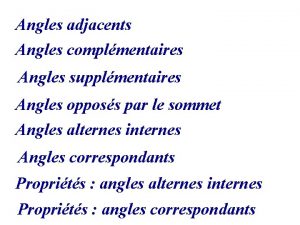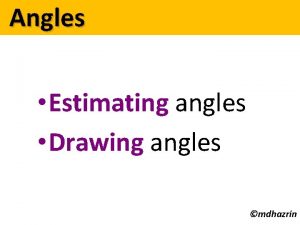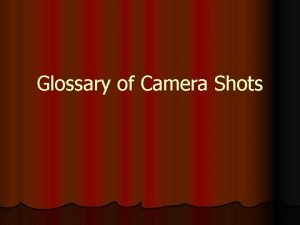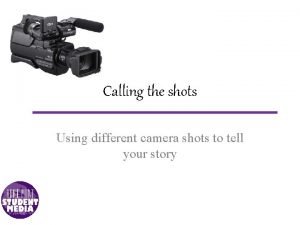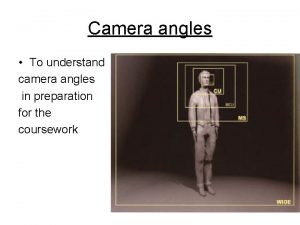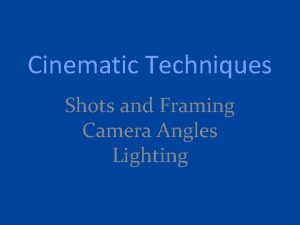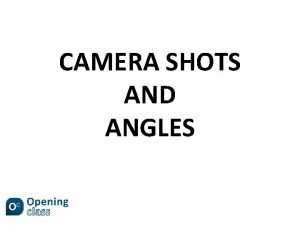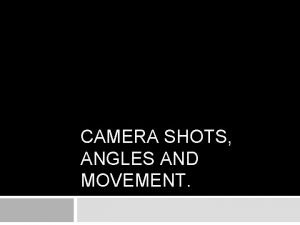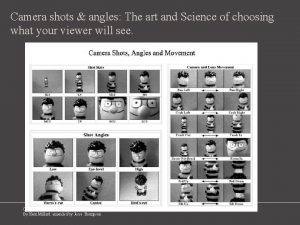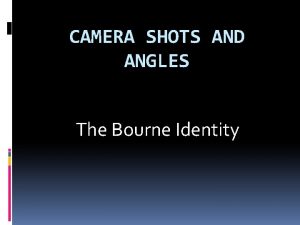Camera Shots and Angles How to analyse camera




























- Slides: 28

Camera Shots and Angles

How to analyse camera work • 1. Identify the key points of interest in the media text. • 2. Identify the camera shot/angle/movement. • 3. Establish what this denotes to the reader. • 4. Consider what it connotes to the reader – what emotion are they expected to feel?

Aerial shot An exterior shot filmed from the air. Often used to establish a (usually exotic) location.

Arc shot A shot in which the subject is circled by the camera.

Bridging shot A shot that denotes a shift in time or place, like a line moving across an animated map.

Close up A shot that keeps only the face full in the frame.

Mid shot The shot that utilises the most common framing in movies, shows less than a long shot, more than a close-up.

Long shot A shot that depicts an entire character or object from head to foot. Not as long as an establishing shot.

Cowboy shot A shot framed from mid thigh up, so called because of its recurrent use in Westerns.

Dolly zoom A shot that sees the camera track forward toward a subject while simultaneously zooming out creating a woozy, vertiginous effect

Canted angle shot A shot where the camera is tilted on its side to create a kooky angle. Often used to suggest disorientation.

Establishing shot A shot, at the head of the scene, that clearly shows the locale the action is set in. Often comes after the aerial shot.

Handheld shot A shot in which the camera operator holds the camera during motion to create a jerky, immediate feel.

Low angle shot A shot looking up at a character or subject often making them look bigger in the frame. It can make everyone look heroic and/or dominant.

High angle shot A shot looking down on a character or subject often isolating them in the frame.

Over-the-shoulder shot A shot where the camera is positioned behind one subject's shoulder, usually during a conversation. It implies a connection between the speakers as opposed to the single shot that suggests distance.

Pan A shot where the camera moves continuously right to left or left to right. An abbreviation of "panning".

Point of view (POV) shot A shot that depicts the point of view of a character so that we see exactly what they see. Often used in Horror cinema to see the world through a killer's eyes.

Tilt • A shot where the camera moves continuously Up to Down or Down To Up. A vertical panning shot. A tilt to the sky is traditionally a last shot in a movie.

Bird’s eye view shot A shot looking directly down on a scene rather than at an angle.

Tracking A shot that follows a subject be it from behind or alongside or in front of the subject.

Two shot A medium shot that depicts two people in the frame. Used primarily when you want to establish links between characters or people who are beside rather than facing each other.

Whip pan A shot that is the same as a pan but is so fast that picture blurs beyond recognition. Usually accompanied by a whoosh sound.

Extreme close up Focuses on one facial feature – usually eyes or mouth to show expression or emotion.

Worm’s eye view shot A shot looking directly up at a scene, rather than at an angle.

Long shot – allowing for more important characters to be seen The suits. Black out glasses, and guns suggests spy films The serious faces (straight closed mouths, narrow direst eyes, open chest) suggests they are the main characters as it compares to the female yellow women. Still close enough to show their facial features Portrays different locations, London and snowy mountains. Suggesting to readers there is a lot of action in the film Old school font, thin stands out from the grey background Characters are built into the flames- suggesting the genre of the film could be an action film Cowboy shot – reflecting a location in the film, this is suggested in the hats and old shotguns Fires can link to the genre of action The colour yellow of her dress could reflect energy, full of life which could represent her personality Background is faded makes the characters stand out The female has a open mouth with a cheeky smile and is looking down, suggesting she looks down at people, could be the villian in the film

Hunger Games Analysis Mid, wide shot – connotes the crowd behind, that they are supporting Simple stark white lighting, makes face pale, suggest and dramatizes her emotions Stance shows ready for action/fight. Readers are anticipating. Only focused on her face, shows her important in this scene Sci fi, future fantasy because of the bow no longer have archaic, it has had a modern twist applied to it All black clothing, black impulse impurity, pain, evil and revenge Larger crowd suggests a celebration or a large important gathering. Close up - Close enough to have a full focus on her faces, conveys her emotions and feeling to the read as they are able to see her facial movement /. He straight flat toned face( no open mouth, wide open eyes, jawline out, pointed chin) Brown, dark green and grey are colours which represent the poor, dirty. Her standing in front of them suggest she was once them as they are all looking the same way. The straight arm and the draw of the bow suggests action is about to happen

Mid, body shot, portrays her feminist top Stark white lighting, showing off her facial expressions Quotes intrigue the audience making them want to read it White background brings out her body, making her stand out Body positivity. Defeating capitalistic views Fist pump symbolises support and rebelling, her rebelling from capitalistic view of women not being dominate Close up showing her facial expressions, right side lip lifted with a closed month, direct eye contact with reader. Connotations with a cheeky funny side Clear themes of the cover, power, women and love Peach coloured fontfriendly colour and reflex femininity The peach, black and grey coloured font make reader look at the whole magazine as it creates a ‘c’ shape on the cover The black font stands got mimicking herself
 Camera shots and angles quiz
Camera shots and angles quiz Camera angle
Camera angle Camera shots angles and movements
Camera shots angles and movements Long shot angle
Long shot angle Property of vertically opposite angles
Property of vertically opposite angles Harry potter extreme long shot
Harry potter extreme long shot Remember the titans film techniques
Remember the titans film techniques Art
Art Media camera shots
Media camera shots Canted camera angle
Canted camera angle Extreme close up shot example
Extreme close up shot example Camera shots media studies
Camera shots media studies Camera shots
Camera shots Bias through statistics and crowd counts
Bias through statistics and crowd counts Bias through statistics and crowd counts examples
Bias through statistics and crowd counts examples Bias by photos captions and camera angles examples
Bias by photos captions and camera angles examples Intersecting chords
Intersecting chords Undermined enamel
Undermined enamel Multi camera production
Multi camera production Camera moves
Camera moves Sing street camera angles
Sing street camera angles Technical codes
Technical codes Vertical
Vertical List of camera angles
List of camera angles Game camera angles
Game camera angles Supplementary angles that are not adjacent
Supplementary angles that are not adjacent Lesson 8 solve for unknown angles—angles in a triangle
Lesson 8 solve for unknown angles—angles in a triangle The spices flavoring the meal were quite distinctive
The spices flavoring the meal were quite distinctive Cut-away shot
Cut-away shot
